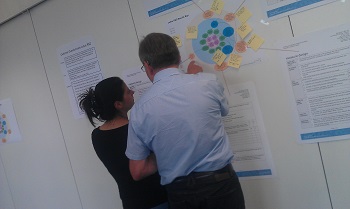Is Your KPI At The Right Level?
by Stacey BarrMake sure that every KPI, measure or metric is aligned at the right level, so it’s in the hands of the right person to monitor and improve its performance.

In my research for writing a white paper on measuring government outcomes, one pattern I noticed was how many operational KPIs were included in strategic plans. This means that those operational KPIs were the measures that the senior leadership teams planned to use, as evidence of achieving their strategic goals.
This is a prime example of putting KPIs or performance measures at the wrong level in an organisational system.
All organisations have different levels of results, outputs and outcomes.
Organisational results, outputs and outcomes link in a cause-effect hierarchy (actually, it’s not quite that linear and more like a multi-relational system). And how these results, outputs and outcomes are linked is based on how the organisation is structured.
Management structure might seem like the obvious levels to align KPIs to, but that can be a mistake.
Management levels don’t make good KPI levels.
If we focus too much on management levels, it’s easy for a system of KPIs to be too simplistic, due to tendencies like these:
- Being action-oriented, where strategic goals cascade to projects and then to milestones or tasks, aligned to whomever is responsible for doing the different actions.
- Being too linear or additive, where strategic goals are copied and pasted into each business unit and the KPIs just become local versions of the strategic KPIs, which is often the case with costs, safety metrics and HR metrics.
- Being too traditional, where each manager and their business unit just measure what they’ve always measured, without any attempt to align to organisational strategy.
The hierarchy of KPIs has more to do with the processes of the organisation, and not that much to do with the management structure.
Even flat organisational structures have levels of KPIs.
Harald Matzke runs a technology company called cubus, in Germany. While facilitating the various cubus teams through PuMP, he discovered how cubus could have a flattened management heirarchy:
“We made a decision to completely get rid of the hierarchical structure, including the top management. Now we have 35 people in the company and we group them in five teams and these five teams are working self-organised. There’s no more boss in those teams. The principle rule is the one who’s the expert in a domain, he takes all the decisions in the domain and he’s also responsible for the result that he will create with those decisions.”
The results that Harald mentions were the basis of what the cubus teams measured. But even with the flat management structure, he and his 34 colleagues still have, and use, a KPI hierarchy. They created it collaboratively, using PuMP’s Results Map:

This KPI hierarchy spans the natural levels of any organisational system, irrespective of the management structure.
Organisations are systems made up of processes to get things done.
If the captain’s attention is on the ship’s hold, then whose attention is at the helm? Everyone needs information that helps them monitor and manage the results they are directly responsible for.
It’s only logical that results, and their measures, are clearly aligned to where in the organisational system they can inform decisions and actions. The easiest way I’ve found to describe useful layers or levels in an organisational system is with these four:
- Level 1: Overall organisational impact, which includes the delivery of the mission, achievement of the vision, and value delivered to stakeholders.
- Level 2: Current strategic results for the organisation, which is essentially the strategic goals the leadership team has decided are the best way, right now, to have more organisational impact.
- Level 3: Process results, which are the outcomes of the organisation’s end-to-end business processes, such as marketing, sales, service delivery, recruitment, finance, training and development – and a load of others. But, it’s only the outcomes that currently have the biggest impact on the strategic results of Level 2.
- Level 4: Sub-process or task results, which are interim results produced within the sub-processes or tasks of end-to-end business processes of Level 3. But, it’s only the interim results that currently have the biggest impact on the process results of Level 3.
In PuMP, we use a Results Map to help place goals, and then their measures, into the right levels. And there’s no need at all to align anything to the management structure of the organisation, to make this work! Sure, different parts of the organisation, like business units or teams, will own some of the results in the system-based hierarchy. But the focus is on making the whole system work better, not suboptimising the business unit or team.
Use these 4 questions to identify if your KPI is at the right level, or not.
You could, if you had plenty of time and wherewithall, create a Results Map for your organisation. And then audit your entire system of KPIs and realign them to that Results Map. If you have a good working knowledge of PuMP, and its techniques for measurability of goals and design of measures that align to goals, this is possible.
The alternative is to deal with it either one KPI or one KPI report at at time. You’d ask and discuss just four simple questions:
- What is the result that the KPI directly gives evidence of?
- At which level in the organisation system (see the 4 levels above) is this result created?
- Who would be the person or role to take action to improve the result the KPI is giving evidence of?
- Is this the person or role who is the owner and primary user of the KPI?
If the answer to the fourth question is ‘no’, then you simply work with that person to explore how they could or should be the owner of the KPI. Then, in time, you’ll gradually get all your organisation’s KPIs at the right level.
If a leadership team is tracking operational KPIs, who is steering the ship?
[tweet this]
Connect with Stacey
Haven’t found what you’re looking for? Want more information? Fill out the form below and I’ll get in touch with you as soon as possible.
167 Eagle Street,
Brisbane Qld 4000,
Australia
ACN: 129953635
Director: Stacey Barr




